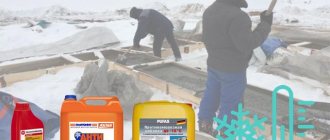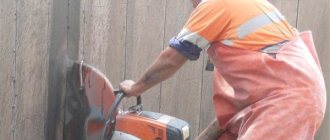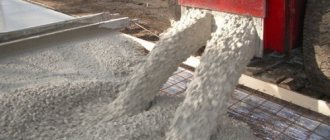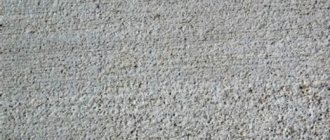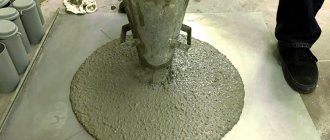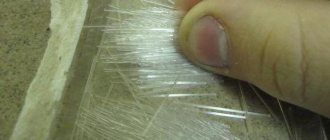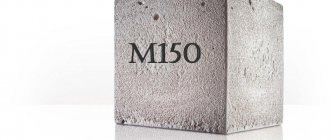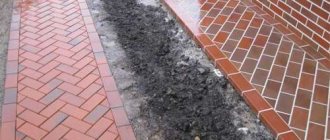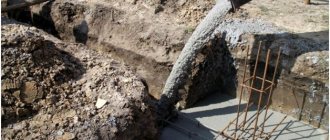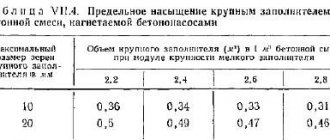Additives to concrete for waterproofing - types, properties
Everyone knows that concrete is the most durable building material, but along with fairly high strength characteristics, it has low moisture resistance. Since inside the concrete layer there is a huge number of pores, capillaries and microcracks, they gradually fill with water, which causes destruction of structures. To increase the waterproofing properties of this material, concrete additives are used to make it waterproof.
There are two types of such additives: those that are applied to hardened concrete and plasticizers that are added directly to the solution before it is poured. The latter option is preferable, since in this case the concrete receives maximum protection from moisture.
What are supplements?
Water-repellent additives fill all the voids in the concrete mass and displace the air trapped in the mixture. Thanks to this, the concrete is compacted and becomes resistant to moisture, while all the improved characteristics do not change throughout the entire life of the structure.
Healthy! Hydrophobicity is a physical property of molecules that “try to avoid” contact with an aqueous environment.
The composition of hydrophobic additives for concrete includes: ferric chloride, calcium nitrate and silicate glue.
Water-repellent additives also include:
- salts of naphthenic acids;
- paraffin;
- calcium salts;
- stearic acid.
These substances do not enter into a chemical reaction with the concrete solution and, in fact, are only mechanical impurities that perform only their main function - they increase waterproofing properties.
In addition, water repellents include any substances that are capable of enveloping the walls of pores, protecting them from the influence of moisture.
Also, silicone compounds based on:
- alkoxysilanes;
- hydrocontaining siloxanes;
- potassium alkylsilicane.
In addition, water-repellent additives have other advantages.
Advantages and disadvantages of water repellents
Special additives that “lock” pores in concrete have a lot of positive properties:
- They increase the strength characteristics of concrete (by increasing the density of the solution).
- Increase the mobility of the sand-cement mixture. This eliminates the need to use plasticizers.
- They allow you to significantly extend the life of the building, save time and consumption of construction resources.
- Increases the water resistance of concrete to level W
- Increases frost resistance by 50-100 cycles.
- Protect the reinforcing frame from corrosion.
- Increases compressive strength by 30%.
In addition, today there are new waterproofing additives on the market that not only fill all the voids in the concrete “body”, but also begin to swell with increased contact with moisture.
The only disadvantage of water-repellent additives is the increase in thermal conductivity of the concrete structure. The fact is that heat is usually better retained precisely thanks to the air bubbles in the concrete. If the hydrophobic additive displaces all the air, the thermal insulation properties of the material will significantly decrease. However, such problems are easily solved with the help of finishing materials.
When choosing waterproofing additives, you need to pay attention to their type and brand.
Types of additives
Waterproofing additives are sold in the form of: ready-made powders that only need to be added to the concrete solution; compositions that are pre-dissolved in water; liquids.
There are three types of waterproofing additives in concrete:
- Polymer. If you add an additive of this type to a liquid solution, the concrete will become waterproof and its mobility will increase. Polymer compositions cover the fillers (crushed stone and sand) with a protective film, due to which hydrophobization is carried out.
- Plasticizing. In this case, the hydrophobic characteristics are increased either due to the film that forms inside the composition or due to the fact that the additive particles gain a surface charge. The latter option uses polycarboxylate, which is also responsible for increasing the strength characteristics.
- Colmatizing. These additives increase the strength of concrete, making it resistant to aggressive organic and inorganic environments. Penetrating into the cement-sand mixture, calmatizing compounds fill its pores with fine, waterproof, mineral particles and soluble substances. During the hydration process, all components combine and solidify.
Healthy! If you want to protect the cracked surface of hardened concrete from moisture, you can use a pressure-type sealant.
If we talk about the consumption of additives in concrete for waterproofing, then everything depends on the composition of the mortar. If you are preparing a regular cement-sand mixture, you will need about 1 liter of additive per 100 kg of batch. When mixing gypsum or lime mortars, the volume of the additive is reduced by 30%. Typically, no more than 1 liter of water repellent is used per 20 m2 of concrete surface.
Having decided what kind of waterproofing additives there are in concrete, all that remains is to find out about the best manufacturers.
Manufacturers of waterproofing additives
Today there is a fairly wide selection of different additives on the market; let’s look at the most reliable and effective of them.
Penetron
The most popular among builders today are additives from the American manufacturer Penetron ADMIX. This is a new type of additive that increases water resistance depending on the activity of the aquatic environment. The greater the effect moisture has on the surface, the more the composition expands inside the concrete mass.
Thanks to Penetron ADMIX, the water resistance of concrete increases to a maximum level of W 20. At the same time, the strength characteristics of the material increase by 20%, and frost resistance by 100 cycles. No efflorescence appears on the surface, so this composition can be safely added even when using decorative concrete.
The additive is sold in powder form, 1 kg is enough for 100 kg of cement (not concrete). Penetron ADMIX costs 325 rubles per kg.
Crystal
This domestic analogue of Penetron is also a high-quality additive. A powdery, environmentally friendly composition is added to liquid concrete and increases its water resistance to W 16. This is quite enough for the surface to withstand quite strong water pressure.
In addition, “Crystal” doubles the strength characteristics of concrete and increases the frost resistance of the composition by 60 cycles. Does not form efflorescence on the surface. The composition costs from 180 rubles per kg.
It is also worth paying attention to the following water-repellent additives.
Brand Features Packaging, l Price, rub
| Tiprom K | Additives are divided into 3 groups based on the depth of penetration into concrete and the level of protection: low, medium and high. They have dirt-repellent properties. Consumption 0.2 l/m2. | 5 | 1 150 |
| Disom-Hidrofugo | Colorless liquid composition based on siloxane. Apply to hardened concrete. Suitable for concrete and plastered surfaces, brick, tiles, ceramics. Consumption is about 0.4 l/m2. | 20 | 11 500 |
| PLYONIT ACTIVE VodoPregrada | Sold in liquid form. The additive is used both when mixing cement-sand mortar and for processing ready-made surfaces. Can only be used at positive temperatures from +10 to +30 degrees. Consumption 0.2 l/m2. | 10 | 875 |
| Aquasil | The composition contains a minimum content of alkalis. Differs in explosion and fire safety. Retains its properties for up to 30 years. Consumption 0.3 kg/m2. | 10 | 4 000 |
| Polyfluid | Liquid colorless solution based on resins. Has antiseptic properties. Consumption 0.4 l/m2. | 19 | 8 000 |
| Penta 811 | The additive is most effective for surface treatment of porous concrete, slate, marble, shell rock, gypsum and much more. Also used as an additive for liquid solutions of concrete, plaster and for cut-off waterproofing. Consumption 0.2 kg/m2. | 10 | 2 500 |
Thanks to water repellents, you can significantly improve the characteristics of concrete. If it is not exposed to moisture, then mold and fungi will not form on its surface, and the reinforcing frame will not be subject to the destructive effects of corrosion. All this will increase the service life of the building.
zamesbetona.ru
Why are antifreeze additives needed?
Under normal conditions, concrete hardens at temperatures ranging from plus 5 to 35 ° Celsius.
But what happens if the temperature drops?
The lower the air temperature, the slower hardening will occur. At temperatures below zero, the water in the concrete solution begins to crystallize and the hardening process stops. Ice crystals disrupt the bonding process between concrete and reinforcement, further promoting its peeling.
For work with concrete, it is desirable that the average daily air temperature exceeds + 5 ° Celsius. At temperatures below –4° Celsius, concrete loses up to 50% of its strength.
If the temperature either rises above zero or drops below, the concrete either gains strength or stops. As a result, hardening takes longer.
It is advisable to carry out concreting in the warm season. But the climatic conditions in most regions of Russia are such that the optimal temperature for working with concrete occurs only during very limited periods. Freezing construction for six months due to the onset of cold weather is not always profitable. There are also disadvantages to concreting in the warm season: in the summer heat, concrete sets too quickly, and in the fall there is frequent precipitation.
Possible reasons for concreting in the cold season:
Concreting on soft soil, which is difficult in the warm season.
The desire to save on cement, since it is cheaper in winter.
There is an urgent need to start construction.
To ensure hardening, special measures are taken when concreting in winter:
covering with film and insulation;
arrangement of temporary shelter heated by heat guns;
With a slight decrease in temperature, increase the amount of cement in the solution.
All types of heating are quite complex activities, which also require additional costs: the concrete must be heated evenly or not allowed to cool during the entire period of gaining critical strength. Winter concreting may require an investment of 20-30% more than summer concreting.
The hardening time depends not only on the air temperature, but also on the type of concrete.
If concrete manages to gain critical strength before frost, then after thawing, hardening will continue. But if concrete that has not reached critical strength freezes, the water will crystallize, and cavities and cracks will appear in the concrete, reducing its strength.
If there is no data on the critical strength, it is taken as 70% of the design strength.
The introduction of antifreeze additives is the simplest and most cost-effective option for concreting at low temperatures.
Waterproofing additive for concrete SinZatim Crystal
SinZaTim Crystal - a chemical additive designed to reduce permeability, increase frost resistance, and corrosion resistance of concrete due to the chemical effect on the hydration processes of Portland cement;
Recommended dosage is 0.5% by weight of cement.
Designed for:
— To increase the water resistance, crack resistance, frost resistance, and corrosion resistance of concrete;
— For producing cast self-compacting concrete mixtures.
Advantages:
— Possibility of creating self-compacting concrete mixtures with optimal viscosity for laying and increased cohesion and non-segregation;
— Possibility of obtaining abrasion-resistant concrete;
— The additive is absolutely safe, approved for use in domestic drinking water supply;
— Compatible with other additives: viscosity regulators; air-entraining; and plasticizing.
Specifications.
| Indicator name | Meaning... Show more |
SinZaTim Crystal - a chemical additive designed to reduce permeability, increase frost resistance, and corrosion resistance of concrete due to the chemical effect on the hydration processes of Portland cement;
Recommended dosage is 0.5% by weight of cement.
Designed for:
— To increase the water resistance, crack resistance, frost resistance, and corrosion resistance of concrete;
— For producing cast self-compacting concrete mixtures.
Advantages:
— Possibility of creating self-compacting concrete mixtures with optimal viscosity for laying and increased cohesion and non-segregation;
— Possibility of obtaining abrasion-resistant concrete;
— The additive is absolutely safe, approved for use in domestic drinking water supply;
— Compatible with other additives: viscosity regulators; air-entraining; and plasticizing.
Specifications.
| Indicator name | Indicator value |
| Recommended dosage, % by weight of cement in concrete | 0,5 |
| State of aggregation | hard |
| Appearance | Gray powder with white inclusions |
| Solubility in water | Partially soluble |
| Humidity, % no more | 1 |
| Bulk density, kg/m3 | 1000±100 |
| Guaranteed shelf life, months | 18 |
| Increasing the grade of concrete for water resistance | 3 steps |
| Increasing the strength of concrete | Not standardized |
Requires 2 kg per 1 m / cubic meter.
Easy to use.
18 month warranty.
Sold in plastic buckets in 4, 8, 16 kg packaging.
sinzatim.blizko.ru
Precautionary measures
Antifreeze additives contain toxic components, so working with them requires caution:
- Addition of additives to the solution must be carried out while maximally protecting the eyes and hands with special protective equipment.
- If the composition gets into your eyes or mouth, rinse them quickly with water. In case of accidental contact with skin, wash it with soap and water.
- If you have an allergy, no actions should be taken with the components.
- Excess antifreeze solution must be disposed of strictly according to the instructions.
Antifreeze additives should be introduced into concrete while protecting hands and eyes as much as possible.
Waterproofing concrete
Waterproofing concrete is a process by which concrete surfaces such as floor slabs, walls, floors, etc. become waterproof. There are various methods of waterproofing.
Concrete
Concrete is a building material consisting of cement, water, a number of fillers, reinforcing components, chemical and mineral additives. Sand and gravel are used as fillers, and metal reinforcement, as well as glass and plastic fibers are mainly used for reinforcement. Chemical additives make it possible to obtain concrete with special properties. Mineral additives are used to increase the strength of concrete. Additionally, admixtures can be used in place of Portland cement, which is usually the main constituent of concrete.
Waterproofing systems.
There are 2 main waterproofing systems - a comprehensive waterproofing system and a system based on the use of waterproofing membranes.
A comprehensive waterproofing system includes 2 subtypes: hydrophilic and hydrophobic waterproofing systems.
There are various methods for installing hydrophilic waterproofing, the most common of which is crystalline waterproofing. This method is based on the conversion of water contained in concrete into insoluble crystals. The action of a number of hydrophilic waterproofing materials is based on their ability, upon contact with water, to absorb it, expand under its influence and thereby fill the pores of concrete, making it waterproof.
Hydrophobic waterproofing systems are based on the use of various waterproofing coatings, membranes, etc., which are used on the outside of the insulated structures.
Membranes
Waterproofing membranes come in liquid and sheet forms. Liquid membranes are applied to concrete and form a rubber coating about 6 mm thick. The main advantages of this method of waterproofing are high performance in use and low cost.
Sheet membranes are made from bitumen. Such membranes are laminated with polyethylene films and the resulting sheets are glued to concrete. This is a very durable waterproofing material. Sheet membranes are used for waterproofing foundations, underground parking lots, tunnels, etc. The main disadvantage of sheet membranes is that they are glued by hand, which leads to increased labor costs.
Hydrophobic concrete
Unlike hydrophobic membranes, “hydrophobic concrete” represents a completely new advanced technology. It is not based on the waterproofing of ready-made concrete structures, but on the production of waterproof concrete. Hydrophobic concrete is produced by introducing special additives at the production stage. These additives prevent capillary infiltration of water into the concrete, thereby making it waterproof. This type of concrete is successfully used in Asia, Europe and Australia and has proven itself well among builders, since it allows construction work to be carried out even in the rain.
Crystal waterproofing
The installation of crystalline waterproofing is one of the options for installing a comprehensive waterproofing system. Let's look at how this is done. First of all, the area of the concrete surface on which waterproofing is to be installed must be moistened with water, then a primer layer of low-density solution is applied to it, and then covered with crystalline waterproofing material, which is a high-density solution. After this, the chemical diffusion process begins. The high-density crystalline waterproofing solution penetrates the concrete before the low-density solution until equilibrium is reached. Once water enters the concrete, hydration of the cement begins. Hydrated cement reacts with the crystalline waterproofing material contained in the concrete. During the diffusion process, the crystalline waterproofing material is embedded into the concrete to a depth of 30.5 cm. This method of waterproofing is very effective, since the crystals formed in the concrete are protected from any external damage. Another advantage is the heat resistance of the structure in an unchanged state up to 130 degrees. In addition, when installing waterproofing, the resistance of the structure to such a chemical reaction as carbonization increases, resulting in reduced leaching and destruction of concrete; diffusion of chloride ions into the structure is prevented, which in turn protects the reinforcement located in the concrete from corrosion and expansion.
Before you start installing waterproofing
Before you begin waterproofing, there are a number of important factors to take into account. The concrete surface must be clean. It is necessary to remove construction debris, etc., level rough surfaces and seal sinks in concrete. Make sure that the waterproofing material you use can be used with the sink mortar and will not cause a chemical reaction that could cause the concrete to deteriorate. Some materials used for waterproofing are flammable and precautions must be taken when working with them.
The above recommendations will help you waterproof, strengthen and protect your home in the best possible way.
www.damar74.narod.ru
Antifreeze additives
According to their action, antifreeze additives are divided into three groups:
Antifreeze (potash, sodium nitrite, calcium and sodium chlorides). Reduces the pour point of water. The curing time is slightly reduced.
Hardening accelerators (potash, mixtures of calcium chloride with urea or calcium nitrite). The essence of their work is to increase the rate of dissolution of the silicate components of cement, resulting in the formation of salts that reduce the freezing point of the solution.
Sulfates. These salts generate heat, thereby speeding up the reactions occurring in the solution.
The main components of antifreeze additives and their effect on concrete.
Antifreeze additives are dry and liquid.
Potash (potassium carbonate). Accelerates the hardening of concrete, reduces the freezing point of the mixture. It is used in conjunction with sodium tetraborate (borax), since in its pure form it reduces the strength of concrete. The mixture with the addition of potash sets quickly, which complicates installation, and therefore requires the addition of a superplasticizer.
Potassium carbonate is a hazardous substance that requires compliance with safety measures.
Sodium tetraborate. It can be used together with potash or as an independent additive, which preserves the structure of concrete after thawing, reduces the water permeability of concrete, increases its strength and prevents cracking.
Sodium (calcium) formate. Accelerates the hardening of concrete and works as a plasticizer. Used in conjunction with naphthalene lignosulfnate.
As an antifreeze additive, sodium or calcium formate is used in a concentration of no higher than 6% of the mixture.
Sodium nitrite. Reduces the freezing point of water in the mixture. Can be used at temperatures from 0° to minus 25° C.
The substance is toxic and flammable; its use requires caution. It cannot be mixed with lignosulfonic acids, since the reaction product is a toxic gas.
The presence of these components in a complex supplement can be determined by labeling:
M – urea (urea),
NC – calcium nitrite,
M NK – urea and calcium nitrate,
What is waterproof cement used for?
Comments:
Rating: 81
For the construction of objects that are constantly exposed to moisture, waterproof cement is used. Cement is currently the most common building material, which is difficult to do without during the construction of any facility.
Waterproof cement is used in the construction of structures that are subject to constant high humidity.
Sometimes, when constructing a number of structures, water resistance is ensured by complex protective systems. Waterproof cement can greatly alleviate such problems, which is why it is increasingly attracting increased interest.
Necessity of material
After hardening, any cement has a certain amount of air inclusions, which are microscopic reservoirs for penetrating water; and if the picture is supplemented with capillaries present in the thickness of the material, then this entire system will ensure the permeability of cement and the accumulation of moisture inside, which has a detrimental effect on its properties. Small cavities in the form of pores and microcracks in the structure are caused by excess water in the cement mortar during its laying, insufficient compaction of the layer, deformation and shrinkage processes, cracking under mechanical load, etc.
Concrete composition data table.
To create waterproof cement means to eliminate air inclusions by expanding the material itself or filling them with another substance. Such material is necessary in the construction of structures that are constantly exposed to water or high humidity. Such structures include: foundations in wet soils and plinths with low groundwater; basements, cellars, inspection pits; floor screeds in a number of conditions; walls of pools, wells, tanks and other structures. The use of waterproof cements in such cases will significantly reduce waterproofing measures.
Return to contents
According to the mechanism for achieving the goal, the following main types of material are distinguished: waterproof expanding cement; waterproof non-shrinking cement and cement with hydrophobic filling. The mechanism of the protective functions of the expanding composition is based on the fact that a substance is introduced that causes the mixture to expand during pouring and rapid hardening. The principle of operation of the non-shrink method involves the addition of an ingredient that ensures the formation of crystals that compact the structure of the material during hardening without free expansion of volume. The introduction of hydrophobic components into the structure of the cement mixture is explained by their protective functions upon contact with penetrating water (they expand, chemically bind, form crystalline structures, etc.).
Return to contents
Table of proportions for preparing concrete.
Waterproof expansive cement is made by introducing a hydroaluminate-based mixture. The most common composition is the following: aluminous cement (70% by weight), semi-hydrous gypsum (20%), calcium hydroaluminate (10%). This mixture is mixed dry and crushed. Due to the active interaction of the components, the mass expands while simultaneously rapidly hardening. When water is added to the cement mixture, setting of the mass begins within a few minutes and is completed within 10 minutes.
The degree of expansion of the material increases with increasing humidity. Internal expansion continues for quite a long time. After 3 days, the cement should correspond to the M300 grade, and after 28 days - M500. If necessary, increase the hardening time, you can add borax or acetic acid.
Waterproof expanding cement has fairly high waterproofing properties, which increase when the solution is in water. This condition makes it possible to use the material even for dams, dams, and swimming pools.
Return to contents
Waterproof non-shrink cement is also produced by adding aluminate, but in smaller quantities, which is not enough for the overall expansion of the mass. As a result of its influence, a crystalline cement stone is formed, which compacts and strengthens the structure. The non-shrinking mixture consists of aluminous cement in a concentration of 85% by weight. Additionally, asbestos is introduced in quantities of up to 5%. The rest of the volume is occupied by calcium aluminate and semi-aqueous gypsum.
Graph of water to cement ratio for different grades of cement.
After approximately 1 hour of hardening, the composition reaches 75% of its final strength, which is established after 28 days of drying. The desired condition for the mass to harden is a humid environment. If air humidity is less than 70%, then shrinkage processes are possible.
Taking into account that this type of material is intended for structures that are exposed to water for a long time, anti-corrosion substances are added to the cement mortar in the form of a mixture of calcium nitrate, ferrosilicon and aluminum powder. This allows for the protection of metal reinforcing elements.
A homemade composition can be prepared by adding “liquid waterproofing hyperconcentrate” of the Dehydrol 10-2 brand to the cement. This liquid is introduced into the cement mixture in an amount of 4 liters per 1 m³ of solution. For example, you can prepare a waterproofing concrete mixture according to the following recipe: cement - 125 kg; sand - 30 kg; crushed stone - 55 kg; dehydrol - 0.2 l; water - 10 l. The waterproof liquid is diluted with water and then mixed with the remaining ingredients of the mixture.
When preparing a homemade solution, you should avoid getting clay or sand containing it into the composition.
Return to contents
In order to increase the water resistance of cement, special additives can be used. Three main types of such substances can be distinguished: plasticizing agents, sealants and polymer compositions.
Characteristics of concrete after using additives.
Plasticizing ingredients increase the mobility of the solution, covering the cement particles with a kind of shell, displacing air. Sealants ensure compaction of the mixture after the solution hardens. They fill the volume of air formations. Polymer compositions mainly act by increasing the mobility of the solution and forming a polymer water-repellent film. Such compositions are especially effective in cracking cement composition.
Mixtures based on polycarboxylates can be recommended as a universal plasticizing additive. They are introduced into the cement composition in quantities of up to 1 liter per 1 m³ of solution.
The effect of compacting the structure can be achieved by adding components that, after a chemical reaction, crystallize the cement base. The material, reacting with the filler, expands and fills the pores. The most widespread are preparations based on microsilica and some other penetrating additives.
Table of proportions for preparing concrete.
To prepare waterproof cement mortar with your own hands, a wide range of bridging agents is offered. These include foreign-made compositions: Penetron, Vandex, Xaypex, as well as fairly effective domestic compositions: Lakhta, Hydrotex, Aquatron, Hydro, Kalmatron. The structure of such standard mixtures includes, in addition to chemically active ingredients, a cement-sand component. Their introduction into cement (concrete) after it hardens ensures that the product not only seeps inside, but also forms a protective waterproofing film on the outside.
Return to contents
In practice, in private construction, “folk” means of preparing waterproof cement and concrete are often used. We can recommend the most famous ones. The liquid additive is prepared from lye (0.5 kg) and alum (2.5 kg) in 10 liters of water. For 8 kg of cement you need 1 liter of this additive. Another way is this. Coarse table salt (3 kg) is dissolved in 25 liters of water, after which it is mixed with cement until the consistency of thick sour cream. Finally, the third option - linseed oil (7.5 kg) and paraffin (3 kg) are mixed with cement (12.5 kg), after which everything is mixed with water to the desired state.
When preparing waterproof cements, you need the following tools: construction mixer, scales, shovel, measuring bucket, scoop, spatula, trowel.
Waterproof cement will significantly increase the reliability of structures when exposed to moisture. This composition can be prepared from standard ingredients or with your own hands.
tolkobeton.ru
Antifreeze additives, their functions and composition
Up to 10% water is added to the concrete mortar, depending on the purpose for which the mortar is used - for brickwork, foundation or pouring a floor screed.
Hardening of the concrete solution slows down significantly as the temperature decreases. If the temperature reaches minus levels, even not very low (- 3-5? C), the water in the solution begins to freeze. As a result, the concrete practically stops hardening. Instead, it just freezes. When defrosted, it still hardens, but becomes friable and significantly loses its strength characteristics.
To preserve the ability of concrete to gain strength, it is necessary to ensure the presence of a liquid component in it. Antifreeze additives contribute to this.
There are a number of plasticizer additives for concrete solutions on sale. They improve the dispersion of solid components of the solution. This means that the friability of cement, sand, gravel and the transformation of the solution into a suspension increases. In this case, the solution’s resistance to freezing increases to -15? C, and also accelerates the hardening process of the concrete solution.
Antifreeze additives (antifreeze) and plasticizers are produced by both domestic enterprises and foreign companies. Russian products include Relamix, Poliplast and others. You can also find many Chinese-made products on the market.
The problem with antifreeze additives in most cases is that they contain chlorides, which promote corrosion of reinforcing parts. For example, when laying a foundation or screed with reinforcing mesh.
Some manufacturers, such as the Swiss company Sika, offer chloride-free antifreeze additives.
Packaging, transportation and storage
In liquid form, the additive is supplied in bulk in road and rail tanks, as well as in plastic containers of various capacities. In dry form, the additive is packaged in paper or polypropylene bags with a polyethylene liner or soft containers such as MKR (big bags). The additive solution should be stored in closed containers. The dry additive must be stored in the manufacturer's packaging in closed warehouses. During storage, the additive does not emit harmful gases or vapors. The additive "Cratasol" does not change its characteristics when exposed to direct sunlight over a wide temperature range. If the aqueous solution freezes after thawing and homogenization, the “Cratasol” additive completely restores its properties. The additive is transported by any type of transport, in accordance with current regulations. The guaranteed shelf life of the superplasticizer (plasticizer) “Cratasol” in dry and liquid form is 12 months from the date of manufacture.
Our additives to concrete and mortars allow you to significantly save costs on cement. Superplasticizing and plasticizing additives for concrete and mortars of the Kratasol and Kratasol-UT brands, in our opinion, are one of the most popular and sought-after plasticizers for concrete and mortars not only in Saransk and Mordovia, but also in Russia in the summer. Our superplasticizing additives and plasticizers for concrete and mortars have low dosages, which allows significant cost savings. The high quality of our plasticizers and superplasticizers has been confirmed by many laboratories in Saransk, Mordovia, Tambov and Russia.
Buy plasticizer All additives for concrete and mortars
TSK "HydroSar" sells second-generation plasticizers and superplasticizers in Saransk and throughout the Republic of Mordovia under the Kratasol brand produced by the largest manufacturer of specialized construction chemicals in Russia. You can buy plasticizer and superplasticizer at the address: Saransk, st. Proletarskaya, 130. Vitema. HydroSar. Our prices for plasticizers and superplasticizers are perhaps one of the most affordable in Mordovia, because we supply plasticizers and other additives to concrete directly from the plant. When purchasing a plasticizer or superplasticizer, you will receive the necessary advice and instructions on dosages and use. Plasticizers and superplasticizers are sold in 25 kg bags. Additional discounts are provided to wholesale buyers of plasticizers. Buy plasticizer in Saransk, 27-07-08, 8-927-188-7727

